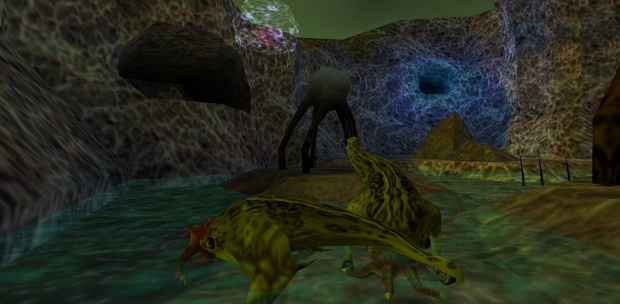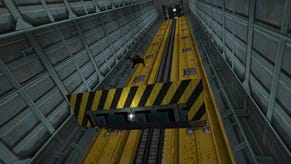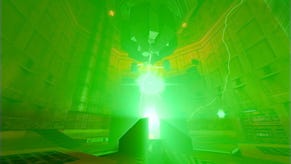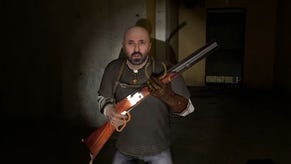Diary: Never Been Half-Lifed, Part Two
Xen-o-phobe
Readers. I crawled to the end. You warned me. After part one of the diary, you really did warn me.
At the beginning, I thought Half-Life was the best game I'd ever played. There were so many finely crafted moments; so many things I learned. I avoided reading the slightest thing on it. I wanted it unsullied. As time went on in Half-Life, I gradually realised that each level is a discrete little chocolate box of incidents, scripted events, little puzzles and touches. There is so much attention to detail in the way that everything is centred on the player's experience, how to psyche you out, how to spook you, how to mess with you. And then, as each new level drags on, you begin to wonder what it is you're aiming for. By the time you reach Xen, you're done. By the time you get to gonad beast, you're completely, oh so really, done. But wasn't it something? But wasn't it really something?
Half-Life is an abusive theme park. Spielberg's admitted that Indiana Jones was heavily influenced by theme park rides, and I feel the same way about Half-Life. It's just a ride that you love and hate. The sheer craft that is present in it - there's such an awareness of psychology - how to play with the player. Level designers and theme park designers must have this in common - a sense of how space and audio can manipulate our minds into behaving in a certain way.
In order to demonstrate how acutely the level designers in Half-Life were attuned to the player, I've gone done a video of my favourite part, in the chapter Apprehension:
It filled me with dread the first time I went into that room. Not only is that the first time you see a horrible sharkbeast, but, y'know, it ate someone in front of you. Not only that - but the audio is perfectly designed to make you feel sick with horror. There are many layers to it: first, the cry of the scientist being chomped. Which, admittedly, is always meant to be comical in this game. But the noise of the Ichthyosaur when you are outside of the water (I found that this is its preferred name, perhaps it gets snooty if you call it sharkydude) is this dread-laden moan, a terrible sigh of 'I'm going to maul you'. It puts the willies up you even now. You know you don't want to be anywhere near the water.
But there are layers still in the audio design. The soundtrack presses down on you like a hot blanket to smother your calm, and then there's the dripping. Always, the dripping. And the echoes. Somehow, you know you're going to face it. But you ignore it. But then you've climbed the ladder and the scientist is there, indicating, irritatingly, at your doom. Well, there's a switch down there, isn't there, you reason. Of course I have to go down there.
And the scientist looked towards this small opening in the wall. You follow his gaze - a technique actors use to have their audience put their attention towards the action - and you realise the next place you are going is along that tiny pole. You inch along it, fully aware that Half-Life's slippy floors could do you over pretty neatly, and then you see it. There's a crossbow down there. It's obviously for sharkthings. Oh god. You have to drop into the cage.
Eventually, it was the curiosity that got me. And the greed. They know that's how we work. They know we want the crossbow. They know we want to know what happens if we try to get it. They know people who play games LOVE. TRINKETS. And especially, we love to collect guns and weapons. My friend Alice informed me, "This is the era in which you measure how far along in a game you are by how many guns you have." And she was right. And I wanted more guns.
So my greed outweighed the fear. I dropped into the cage, picked up the bow, and thought I was safe - I thought the cage would drop. It didn't. I thought I could take potshots at that silly sharkenduden. But it just wouldn't pop up to say hello.
I moved. The cage dropped. I had a sharp intake of breath and as I hit the water I whined to myself. "Why," I asked. "Why did I say I'd do this."
As soon as the thing moves about in the water all fear is removed. It makes a silly noise and flips about like a confused hummingbird. Such is the era, where waterbeasts do not behave themselves. A while later, you'll see I encountered one flying in the sky all nonchalant-like.
From then on it becomes more action-orientated, and I found that made the latter half of the game much weaker. The real strength of Half-Life is when alarms are going off, you're crawling through a vent with flashing lights on, you think of yourself as some John McClane motherfucker. You need to feel vulnerable, or scared, or claustrophobic. But the more guns you get, and the more open space you find where shootouts take place, the less you feel this way, even though ammo is so scarce I wanted to throw my mouse at a wall. The real talent's in the levels that made you feel something. Made you feel like you were in an abusive theme park instead of a military shooter.
Part of the reason I found the playthrough so difficult was not because of the trackpad (I did intend on doing it on trackpad all the way through just to see if it could be done - IT CAN'T) but because of course now we've moved away from the slidiness of control, invisible box-ladders, and the need for a crouch-jump - even Mark Laidlaw, the writer of Half-Life himself, told me he regretted the long jump. Level design has changed, or, perhaps it is just that we don't really do things exactly the same way any more. There's very little hand holding. For example, in Blast Pit, you face a three-headed monster. Stop by a certain place in the level you'll find the same old blue-shirted security guard (I do love him) tell you the monster is blind but it can hear things. There are grenades on the box next to him. Now if you'd had the audio off, too low, or if you plain weren't listening, you might have really suckered yourself. But if you listen in Half-Life, the signs to read are all there. Games these days do everything but have a flashing neon light above something saying 'GET IT HERE'. Actually, sometimes they literally have a flashing sign pointing which way to go.
Some lovely set pieces are in there: the Blast Pit hydra, the On Rails section that is a lovely piece of mine-cartesque puzzle-making - and there's even a bit where you catapult yourself on the cart over some radioactive goop. The shark was a real highlight - and taking down the helicopter was something I bet was pretty amazing back when we didn't do that all the time in games. PEW PEW. Exploded.
One thing I did notice in myself after a while was my willingness to waste and to suicide, created by the constant need to save after every jump or shooting section. It somewhat detracted from surprise or tension often, because I'd just barge ahead recklessly, convinced that I'd just reload if something bad happened. The autosaves are not always clear, so saving became something really necessary. In that video you'll see a lot of really stupid things happen, such as my letting the scientist get shot just for funsies, simply because I had a save that was five seconds in the past. Now we very carefully place autosave points, and designate when they are happening very clearly, so that part of you still wants to please the level designer by traversing save point to save point. This is gamier, but I think much nicer.
There's a sharp incline in difficulty after the helo explodes. Trip mines became the order of the day, and ninjas appear, which I took a great deal of pleasure annoying with the attack bugs you get (the ones with the magnificent idle animations). I really grinded these parts. And then I watched a speedrun through Half-Life and I lost all morale. Do not do this. They took under an hour, whilst my entire life had been sucked away by this game.
Kieron told me he didn't finish Half-Life, and many games journalists I spoke to told me they hadn't. Alec said it took him two years to do it. When I told Patrick Klepek this, in a bit of Giant Bomb crossover fanfic, he seemed surprised. But I am not surprised. When you get to Xen, you're mentally tired. There was an obvious ending there, one that was necessary. It would have made sense to find the G-Man right there after you'd rocket launchered the testicle monster (testicle monster?!), G-Man reclining on a chaise longue, attempting to seduce Gordon in his rude, slightly smug way. But instead, the game goes on and on in the manner of a sort of weird, slightly off Doom. All of the signs you've learned to read in the previous levels - such as how to navigate, what is going to hurt you, what things are switches - even how healing works - all of these things are redone and you have to discover them. This is why pacing in games is more important than we think. Because this is where all the games journalists gave up. They got what they wanted, which was a well-told sci-fi dystopic story, in which the government turns against you, the lowly scientist. You certainly don't want to end up with weird purple alienmagic up your arse. Like I mentioned in the previous diary entry, perhaps the end of Raiders of the Lost Ark was too much of an influence here.
Half-Life is something I'll always regret not pushing to be put in the list for How Videogames Changed The World. I guess I was the PC gaming representative, besides Charlie. This game made my hands shake over my keyboard. The last time I felt like that was Amnesia: The Dark Descent. And that game had cupboards to hide in. Half-Life did me no such courtesy. It's raw, and it's clever. That Apprehension chapter was perfect. I think Half-Life did change the landscape of games, along with Thief. Half-Life made character vulnerability something games could find momentum and emotional purchase on.
Happy 15th Birthday, Half-Life.
Bonus footage: In my travels I stopped off at Kieron's house and he made fun of my trackpadding.
I also listened to a lot of Woman's Hour whilst shooting aliens. Gordon would listen to Radio 4. He's intellectual. And apparently a feminist.










